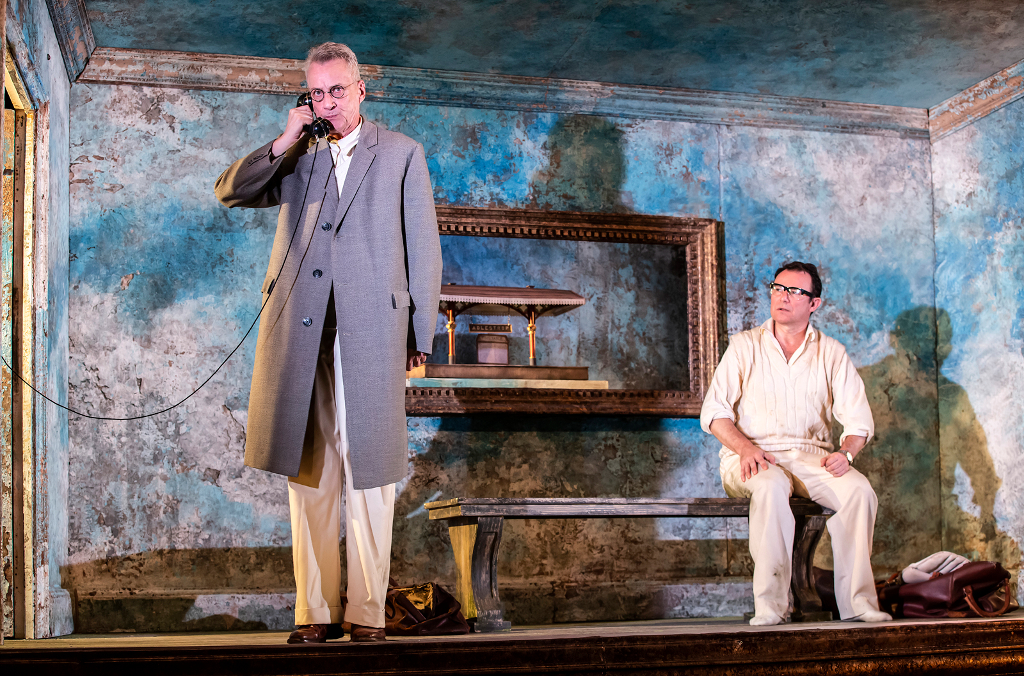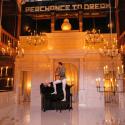Much of cricket comprises waiting – you wait on the boundary to hear news of the toss, you wait your turn to bat, you heed the call of your batting partner to wait to see if a run is on, you wait for the rain to stop. A friend once told me that he played cricket in order to make the rest of his life seem more interesting. There is something in that observation that would appeal to both principals in this play for sure.
Two men bicker on the boundary as they wait their turn to bat. In at five and six, one is keeping score (and "working the telegraph", as cricket’s arcane argot has it), while the other tends a sore ankle, the oft-described "genteel" pursuit of recreational cricket the source of many an injury. The incoming batsmen are Samuel Beckett (scoring) and Harold Pinter (screaming – well, whinging – about the pain), the two great playwrights and lifelong lovers of the game. Over the next 70 minutes in Shomit Dutta’s tight, funny, absurd play, they spend much of their time waiting – mostly for the mysterious teammate and driver, Doggo (geddit?). Like Test cricket, the play rewards a little prior knowledge, with references to the two men’s work on stage and screen and quotes from Shakespeare and the classics fueling a very literary arm-wrestle between the two alpha males, each spiky and unwilling to back down. Stephen Tompkinson lends the older man a wit as dry at the Oval’s outfield in 1976 while Andrew Lancel as the younger Pinter (both, pictured above) can be as hostile as the West Indies attack who bowled their team to an unforgettable victory. Both men, as their work attests, know how to find the insecurity in themselves and others, and chip way at it on a nagging line and length. (Translation for cricket uninitiates: rub salt into the wound.)
Like Test cricket, the play rewards a little prior knowledge, with references to the two men’s work on stage and screen and quotes from Shakespeare and the classics fueling a very literary arm-wrestle between the two alpha males, each spiky and unwilling to back down. Stephen Tompkinson lends the older man a wit as dry at the Oval’s outfield in 1976 while Andrew Lancel as the younger Pinter (both, pictured above) can be as hostile as the West Indies attack who bowled their team to an unforgettable victory. Both men, as their work attests, know how to find the insecurity in themselves and others, and chip way at it on a nagging line and length. (Translation for cricket uninitiates: rub salt into the wound.)
Enough cricket. The game’s capacious scope (something Dutta understands in the way only a cricket tragic, or obsessive, does) can accommodate any number of metaphors, examine any aspect of life, reveal much of what makes us human – good and bad as this week’s report from the Independent Commission for Equity in Cricket shows to devastating effect. Life, as some wag once remarked, is a microcosm of cricket.
While waiting to bat, Pinter and Beckett muse on each others’ careers, and how they’ve never written about the Cotswolds (the region in which they find themselves) nor even about the outdoors much at all. As is the case on the 22-yard strip of rolled grass on which batter and bowler duel, what matters most to them is what goes on inside the head, not outside the room.
Later, they wait near a tree (natch!) for their lift that may or may not come, a little dishevelled from the booze taken after the match and ponder existence itself, trying to locate Doggo in the scorebook, the ultimate arbiter of a cricketer’s presence. Pinter discovers, to his shame, that his shambolic innings included the run out without facing (the closest cricket gets to erasing a player from planet Earth) of Arthur Wellard, a celebrated England batsman and notorious smiter of sixes who did turn out occasionally for The Gaieties, Pinter’s (and Dutta’s) club. Could he be after revenge in leaving them to fester in the fearful silence of a village green at midnight?
The final scene finds them on a rural railway platform, waiting for a train that may or may not be timetabled, Pinter in a fever dream, Beckett both there and not there – like the train. It captures a world before smartphones when few places were as isolated as a dark, deserted station, promising progress, but uncertain as to when, the means of salvation always the other side of the horizon.
David Woodhead’s gorgeous set comes bathed in Howard Hudson’s light: sharp then dim, perfectly suggestive of an English high summer day drifting into a warm, still night. Props are introduced through an endlessly amusing trompe l'oeil backdrop, and their authenticity positions the play perfectly in the early 1960s (which, given cricket’s reluctance to move with the times, is the early 1950s for anyone else).
Just a Jonny Bairstow pull shot away from Lord’s itself, Guy Unsworth’s production at Hampstead Theatre knows an audience that it is unafraid to flatter and challenge and, like the Ashes Test to be played concurrently with its run, never patronises them by making things too obvious; the absurdity of it all is ever present.
Cricket and the works of Pinter and Beckett enjoy an outsize influence on the cultural life of the nation compared to their popularity, but their enduring collective presence speaks to tapping into a certain element in the psyche, a place that is definitely there, but never quite visible. You’ll find it – all you need to do is wait.














Add comment